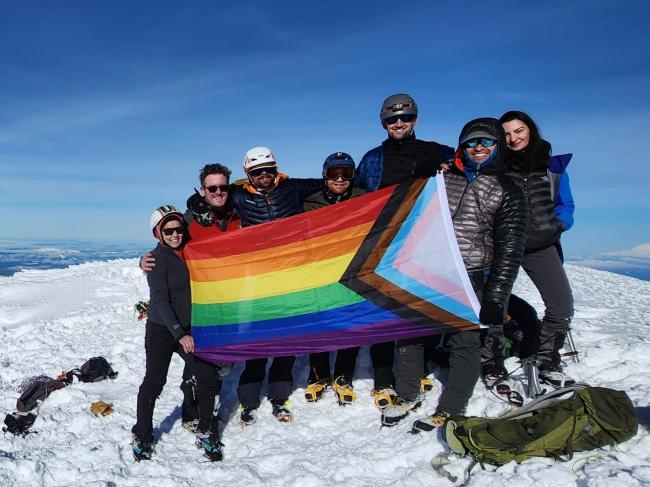Standard Mt. Hood disclaimer: conditions vary by the hour, experience interpreting conditions and forecasts are essential for safe alpine travel.
There are several good trip reports that outline the route and condition aspects of this trip, so I'll try to stick to what was specific about this activation.
Our group of seven departed Timberline Lodge at 2:30am with plans to assess conditions at Devils Kitchen and determine specific route options there. The snow was fresh and deep so we were grateful for the cat track up to the top of Palmer. The group had accordioned quite a bit by the time we reached the Palmer lift house and stopped for food and water at 4:15a. The four of us that were moving well decided to aim for a more involved route: Devils Kitchen Headwall V1 (aka left variation). We assembled the necessary gear, arranged to meet the other half of the party on summit, and pressed on. Immediately above Palmer the soft snow meant a slower, harder pace. There were two parties in front of us but we caught up to them on the Triangle Moraine given they were breaking trail and we were in their tracks. The seven of us (three parties) alternately broke trail to Devils Kitchen where we stashed gear (hiking poles, one person's skis), snacked and rested until we started to get cold.
Above Devils Kitchen the route to the headwall depends on conditions and snowpack. We navigated below the largest fumaroles to climbers right, toward the headwall, and between the obvious fumaroles the best we could. Despite the recent snowfall, there were several places where we punched through 12" of snow into melted out fumarole holes that were another foot down. Despite these obstacles, we reached the base of the headwall as the sun was starting to come up and light up the rime ice structures above us. Here we transitioned to technical tools, donned harnesses, and gave our ice screws, pickets, and rope to the lead climber and started up the route.
DKH V1 is a fairly technical route even in good conditions and the early-season conditions we found were quite thin. The 600' of elevation gain is broken up into roughly three ice pitches separated by sturdy snow (somewhere between mashed potatoes and styrofoam). Progress on the snow was straightforward, but on ice it required careful tool placement, excavating reasonable foot positions, and good ice climbing technique. The lead climber set a three point anchor halfway up the route and belayed up the party. From that point, anchors were not as reliable and we elected to simulclimb once the lead climber was above the final top ice pitch.
From there, the last 500' are a cruise on steep snow up to the summit ridge. Topping out meant getting into the full sun at 9:30am and needing to shed layers. We made the last push to the summit on very tired legs but in good spirits. At this point, I had a chance to look at my phone, had data service, and messaged some chasers that I was close to the AZ despite running late.
Once on summit, I made a quick CQ call, got a few immediate replies, and noticed a spot come through for me before I even had a chance to do it (thanks Tim N7KOM!). The calls came in quickly with the spot, and I got 12 qso within about 10 minutes. One was en route to their own summit, so I let them know I'd be on summit for a bit as we waited for the rest of our party. I set the radio down to have a snack and must have bumped the tuning knob to another frequency. I was surprised it got quiet on the air but was preoccupied by nutrition and rest. After about 30 minutes I noticed the radio error and tuned back to 146.580. I caught two more s2s contacts, gave it a few more minutes and went back to monitoring. I did hear a few PDX locals chasing other summits, but none of them seemed to hear me (later confirmed via other messages). It was odd to not hit metro area well, but on the other hand, several Bend contacts came through with strong signal reports.
After another 30 minutes, our full crew was on summit. We took the necessary photos, confirmed our route to the old chute, and started down.
The descent from the summit to Old Chute begins with a ridgeline traverse called the catwalk. The snow was thick enough here to make it stable, and we crossed to the top of Old Chute. The descent on Old Chute was steep but soft. We were comfortable plunge-stepping as we jealously watched the skiers start their ride back to the parking lot.
From Old Chute to the car is a long steep walk, there isn't any other way to put it. By the time we hit the car, we were down to base layers and carrying everything else in our packs. It was a great January day on the mountain, and I'm glad to have made the activation despite being a weekday mid-morning.




